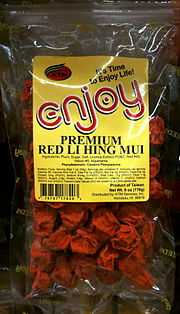Li hing mui

Li hing mui (Chinese: 旅行梅; Jyutping: leoi5 hang4 mui4) is salty dried plum. In most parts of China it is called huamei (話梅). It has a strong, distinctive flavor, and is often said to be an acquired taste, as it has a combination of sweet, sour, and salty taste. It has also been described as tart, and even tangy. Originally from Guangdong Province, the name "li hing mui" means "traveling plum". "Li hing" is "traveling" and "mui" is "plum."
Powder
Li hing (red powder) is found in Hawaii. The red powder called li hing powder consists of ground up-plum skin that has previously been pickled in a combination of licorice, sometimes, but not always aspartame, food coloring, salt, and sugar. Li hing powder is sold separately and can be used as a flavoring usually sprinkled on candy and other fruits notably pineapples and apples. In the United States Li hing mui powder can be found in Hawaii, where local children like to put li hing powder on sour gummy bears, sour gummy worms, sour watermelon candy, sour patch kids, shave ice, sour apple candy, rock candy, popcorn, and arare (also known as kakimochi and mochi crunch).
Alcoholic beverages
Recently, people have also been putting li hing powder into their alcoholic drinks—mainly tequila and cocktails. Many bars in Hawaii replace salt with this powder, since this powder is not only salty, but sweet and sour as well. Other people also feel that it gives a tart and sometimes tangy twist. Many bars in Hawaii also rim their glasses with li hing powder in addition to putting it in the drink.
Note that Li Hing powder is used on different plum varieties, and it comes in different colors. The "red" powder is popular on fruits and assorted red plum varieties. A "white" powder version is more commonly used on dried/dehydrated plums.
In China, huamei are often found in cups of rice wine, like olives in a martini.
In the United States
It was made popular in Hawaii by Yee Sheong, who in early 1900 had begun importing li hing mui and various other preserved fruits i.e. crack seed snacks from China to Hawaii. The li hing mui craze was started by Yee and flourished with the company he founded, Yick Lung. It can be found in Hawaiian and Asian markets.
See also
- Umeboshi
- Saladitos
- List of dried foods
- Food portal
References
- Chan, Janna. “GroupThink: Asian American Foods and Recipes.” GroupThink. 5 July 2005. Janna Chan. 4 Jul 2008. <http://www.jannachan.com/groupthink/archives/000072.html>
- FoodNerd. “FoodNerd!: li hing mui.” FoodNerd!. 17 May 2008. www.paisleysky.net. 2 Jul 2008. <http://www.paisleysky.net/foodnerd/archives/000458.html>.
- Kathy. "A Passion for Food: Gecko on the Curtains, Li Hing, Fried Rice, Shoyu Poke @ Costco, and Xi Mui Soda." A Passion For Food. 24 May 2008. A Passion For Food. 7 Jul 2008. <http://apassionforfood.blogspot.com/2008/05/gecko-on-curtains-li-hing-and-xi-mui.html>.
- Laudan, Rachel. "http://www.flavorandfortune.com/dataaccess/article.php?ID=109."
- Flavor & Fortune. 2005. Flavor & Fortune. 7 Jul 2008. <http://www.flavorandfortune.com/dataaccess/article.php?ID=109>.
- “Li Hing Plum Candy « The Tasty Island.” The Tasty Island. 14 June 06. The Tasty Island. 2 July 2008. <http://tastyisland.wordpress.com/2006/06/14/li-hing-plum-candy/>.
- Lum, Landis. “Does li hing powder pose cancer risk? | The Honolulu Advertiser | Hawaii’s Newspaper.” The Honolulu Advertiser | Hawaii’s Newspaper. 21 Sep 2006. The Honolulu Advertiser. 30 June 2008. <http://the.honoluluadvertiser.com/article/2006/Sep/21/il/FP609210307.html>.
- Martin. “Robot Lounge - Li hing junkies!.” Robot Lounge. 21 Dec 2006. Giant Robot. 2 July 2008. <http://www.giantrobot.com/forums/showthread.php3?s=d01be7183b6da4a991092341d43b902d&threadid=37136&perpage=15&pagenumber=1> and <http://www.giantrobot.com/forums/showthread.php3?s=d01be7183b6da4a991092341d43b902d&threadid=37136&perpage=15&pagenumber=2> (continuation).
- Walter, Claire. “CulinaryColorado: Hooked on Li Hing.” Culinary Colorado. 3 July 2007. Culinary Colorado. 2 July 2008. <http://culinary-colorado.blogspot.com/2007/07/hooked-on-li-hing.html>.